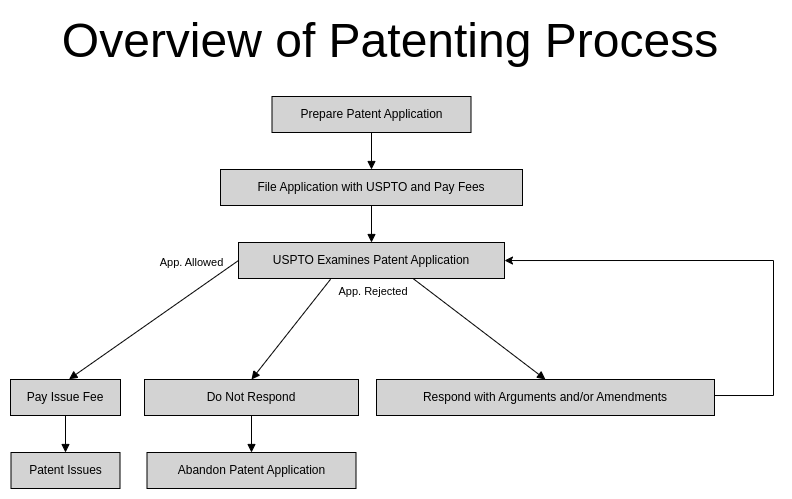Overview of the Patenting Process
By: Brian Downing | Last updated on: 08/14/2024
This article provides a high level overview of the patenting process. While this article is an oversimplification of the actual patenting process, this article should help the reader understand the high level framework of obtaining a patent.
Table of Contents
1. Introduction
This article describes a non-provisional utility patent application.

2. Drafting the Patent Application
One of the first steps of the patenting process is to draft a patent application. This patent application drafting is referred to as patent preparation. Some inventors or companies may choose to have a patent search performed before starting the patent drafting.
There are a few options for preparing a patent application:
a. The patent application can be drafted professionally by a patent practitioner (i.e., a patent attorney or patent agent), such as by Stellar Patent® Patent Preparation and Prosecution.
b. The inventors can perform the initial draft and then hire a patent practitioner to review the patent application, such as Stellar Patent® Patent Collaboration.
c. Certain inventors may qualify for free or low cost patent drafting with a Pro Bono Program.
d. The inventors can draft the patent application themself. There are patent Do it yourself (DIY) systems and software to help inventors.
3. Filing Patent Application with the USPTO
If the patent application was drafted by a patent practitioner, a patent attorney, a patent agent, or someone on their staff will normally file the patent application with the U.S. Patent and Trademark Office (USPTO).
The inventors have the right to file the patent application themselves with the USPTO.
At times, the USPTO will find issues with the patent application and issue a notice to correct. These issues must be addressed or the patent application will become abandoned.
4. USPTO Examines the Patent Application
A patent examiner at the USPTO will examine the patent application. The USPTO's goal is to examine the patent application within eighteen months. The experience of Stellar Patent® is that it is not uncommon for the USPTO to take three years to examine a patent application in technology areas where a lot of patent applications are being filed.
After examining the patent application, the USPTO will either allow or reject the patent application. The USPTO will inform the patent application filer of their determination.
5. Respond to USPTO
When the patent application is allowed, after the USPTO issue fee is paid, the patent will issue shortly.
When the patent application is rejected, this does not mean a patent cannot be obtained. The rejection means that the USPTO has determined that the patent application is not in a condition for allowance in the current condition. There are typically two options when responding to a rejection:
a. Not respond. When a response is not filed with the USPTO, the patent application will eventually become abandoned and the right to patent the invention is forfeited. Also, the invention becomes available for the world to freely use after abandonment.
or
b. Respond to the USPTO with arguments and/or amendments. The USPTO fees paid when filing the patent application includes the initial examination and one additional examination. After these two examinations are used, the USPTO requires more money to be paid to continue the examination process. If after two examinations the USPTO has not allowed the patent application, the USPTO has an internal appeal process to review the patent examiner's decisions.
